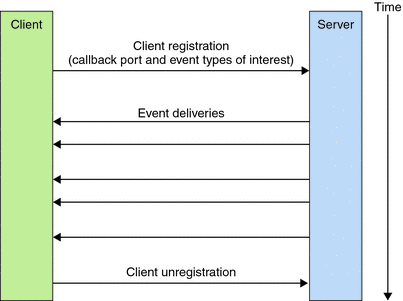CRNP Concepts
The CRNP defines the Application, Presentation, and Session layers of the standard seven-layer Open System Interconnect (OSI) protocol stack. The Transport layer must be TCP, and the Network layer must be IP. The CRNP is independent of the Data Link and Physical layers. All Application layer messages that are exchanged in the CRNP are based on XML 1.0.
Note –
You can run the CRNP only on a global-cluster voting node.
How the CRNP Works
The CRNP provides mechanisms and daemons that generate cluster reconfiguration events, route the events through the cluster, and send them to interested clients.
The cl_apid daemon interacts with the clients. The Sun Cluster Resource Group Manager (RGM) generates cluster reconfiguration events. This daemon uses syseventd to transmit events on each local node. The cl_apid daemon uses Extensible Markup Language (XML) over TCP/IP to communicate with interested clients.
The following diagram shows the flow of events between the CRNP components. In this diagram, one client is running on cluster node 2, and the other client is running on a computer that is not part of the cluster.
Figure 12–1 Flow of Events Between CRNP Components

CRNP Semantics
Clients initiate communication by sending a registration message (SC_CALLBACK_RG) to the server. This registration message specifies the event types for which the clients want to receive notification as well as a port to which the events can be delivered. The source IP of the registration connection and the specified port, taken together, form the callback address.
Whenever an event of interest to a client is generated within the cluster, the server contacts the client on its callback address (IP and port) and delivers the event (SC_EVENT) to the client. The server is highly available, running within the cluster itself. The server stores client registrations in storage that persists even after the cluster is rebooted.
Clients unregister by sending a registration message (SC_CALLBACK_RG, which contains a REMOVE_CLIENT message) to the server. After the client receives an SC_REPLY message from the server, the client closes the connection.
The following diagram shows the flow of communication between a client and a server.
Figure 12–2 Flow of Communication Between a Client and a Server

CRNP Message Types
The CRNP uses three types of XML-based messages. Use of these messages is described in the following table. These message types are described in more detail later in this chapter.
|
CRNP Message Type |
Description |
|---|---|
|
SC_CALLBACK_REG |
This message takes four forms: ADD_CLIENT, REMOVE_CLIENT, ADD_EVENTS, and REMOVE_EVENTS. Each of these forms contains the following information:
ADD_CLIENT, ADD_EVENTS, and REMOVE_EVENTS also contain an unbounded list of event types. Each of these forms includes the following information:
Together, the event class and event subclass define a unique “event type.” The document type definition (DTD) from which the classes of SC_CALLBACK_REG are generated is SC_CALLBACK_REG. This DTD is described in more detail in Appendix F, Document Type Definitions for the CRNP. |
|
SC_REPLY |
This message contains the following information:
The DTD from which the classes of SC_REPLY are generated is SC_REPLY. This DTD is described in more detail in Appendix F, Document Type Definitions for the CRNP. |
|
SC_EVENT |
This message contains the following information:
The values in an SC_EVENT are not typed. The DTD from which the classes of SC_EVENT are generated is SC_EVENT. This DTD is described in more detail in Appendix F, Document Type Definitions for the CRNP. |
- © 2010, Oracle Corporation and/or its affiliates
